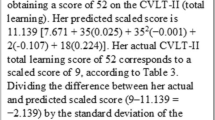Summary
Objectives
To test neurocognitive function in patients with late-onset Tay–Sachs disease (LOTS) using a computerized system to assess whether cognition is a clinically relevant outcome measure of possible therapeutic intervention in LOTS.
Methods
Ten adults with Tay–Sachs disease were administered at least one battery of the Mindstreams Neurotrax system for evaluation of cognitive function. Six sub-scores and a Global Cognitive Score (GCS) were tabulated. A disease specific severity score was also devised with six domains.
Results
Despite identical genotypes, all patients but the two oldest had ≥3/6 sub-scores one standard deviation below normal mean (100); verbal and executive functions were most affected. The severity score measured other functions.
Conclusions
Because of provocative findings on re-testing in patients exposed to miglustat, and despite the very small cohort, cognitive function may be an appropriate and clinically relevant outcome measure for future therapeutic interventions in LOTS.
Similar content being viewed by others
References
Brett EM, Ellis RB, Haas L et al (1973) Late onset GM2-gangliosidosis. Clinical, pathological, and biochemical studies on 8 patients. Arch Dis Child 48: 775–785.
Cox TM, Aerts JM, Andria G et al (2003) The role of the iminosugar N-butyldeoxynojirimycin (miglustat) in the management of type I (non-neuronopathic) Gaucher disease: a position statement. J Inherit Metab Dis 26: 513–526.
Dwolatzky T, Whitehead V, Doniger GM et al (2004) Validity of the Mindstreams computerized cognitive battery for mild cognitive impairment. J Mol Neurosci 24: 33–44.
Elstein D, Guedalia J, Doniger GM et al (2005) Computerized cognitive testing in patients with type I Gaucher disease: effects of enzyme replacement and substrate reduction. Genet Med 7: 124–130.
Elstein D, Pastores GM, Zimran A et al. (2007) Late-Onset Tay–Sachs (LOTS) Disease: Scoring Disease Severity. Washington DC: American Neurological Association.
Frey LC, Ringel SP, Filley CM (2005) The natural history of cognitive dysfunction in late-onset GM2 gangliosidosis. Arch Neurol 62: 989–994.
Harding AE, Young EP, Schon F (1987) Adult onset supranuclear ophthalmoplegia, cerebellar ataxia, and neurogenic proximal muscle weakness in a brother and sister: another hexosaminidase A deficiency syndrome. J Neurol Neurosurg Psychiatry 50: 687–690.
Hobart JC, Cano SJ, Zajicek JP, Thompson AJ (2007) Rating scales as outcome measures for clinical trials in neurology: problems, solutions, and recommendations. Lancet Neurol 6: 1094–1105.
Hund E, Grau A, Fogel W et al (1997) Progressive cerebellar ataxia, proximal neurogenic weakness and ocular motor disturbances: hexosaminidase A deficiency with late clinical onset in four siblings. J Neurol Sci 145: 25–31.
Neudorfer O, Pastores GM, Zeng BJ et al (2005) Late-onset Tay–Sachs disease: phenotypic characterization and genotypic correlations in 21 affected patients. Genet Med 7: 119–123.
Percy AK, Shapiro LJ, Kaback MM (1979) Inherited lipid storage diseases of the central nervous system. Curr Probl Pediatr 9: 1–51.
Platt FM, Neises GR, Reinkensmeier G et al (1997) Prevention of lysosomal storage in Tay–Sachs mice treated with N-butyldeoxynojirimycin. Science 276: 428–431.
Schweiger A, Doniger GM, Dwolatzky T et al (2003) Reliability of a novel computerized neuropsychological battery for mild cognitive impairment. Acta Neuropsychologica 1: 407–413.
Zaroff CM, Neudorfer O, Morrison C et al (2004) Neuropsychological assessment of patients with late onset GM2 gangliosidosis. Neurology 62: 2283–2286.
Author information
Authors and Affiliations
Corresponding author
Additional information
Communicating editor: Guy Besley
Competing Interests: A private grant to one of us (D.E.) for LOTS-related research provided funds for transportation of patients to Jerusalem and paid for Neurotrax testing. G.M.D. and E.S. are paid employees of the Neurotrax Corporation. DE, AZ, IKL and RN had no associations during the period covered in this report such as consultancies, stock ownership, or other equity interests or patent licensing arrangements that may have posed a conflict of interest.
Rights and permissions
About this article
Cite this article
Elstein, D., Doniger, G.M., Simon, E. et al. Neurocognitive testing in late-onset Tay–Sachs disease: A pilot study. J Inherit Metab Dis 31, 518–523 (2008). https://doi.org/10.1007/s10545-008-0884-z
Received:
Revised:
Accepted:
Published:
Issue Date:
DOI: https://doi.org/10.1007/s10545-008-0884-z




